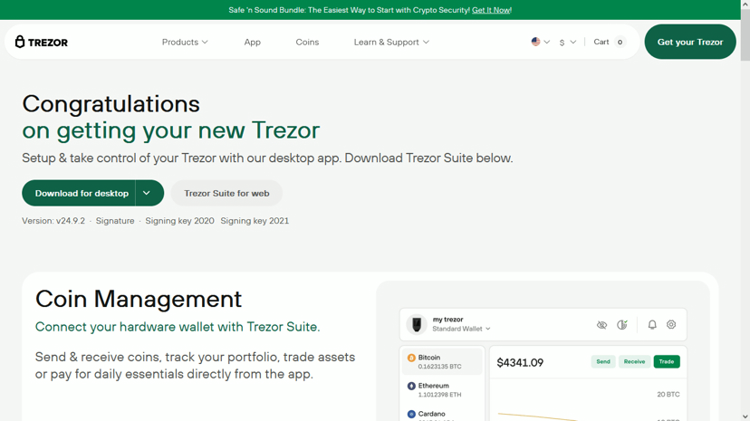
Seamless Security: Mastering Connectivity with Trezor Bridge
In an age where digital asset security is paramount, the Trezor Bridge stands out as the essential link between your hardware wallet and the web interfaces you trust. Designed to elevate user experience, Trezor Bridge seamlessly manages USB communication, ensuring that your cryptocurrency transactions, account management, and firmware updates proceed without a hitch. Whether you're a beginner or a seasoned blockchain aficionado, understanding and leveraging the full power of Trezor Bridge is a game-changer for secure digital custody.
What Is Trezor Bridge?
At its core, Trezor Bridge is a small utility that runs on your computer and facilitates secure, reliable USB communication between your Trezor hardware device and browser-based wallet interfaces such as Trezor Suite, MyEtherWallet, or third-party applications. By abstracting away the complexities of USB drivers and permissions, it allows modern browsers to recognize and interact with Trezor devices effortlessly. In doing so, Trezor Bridge eliminates driver conflicts, improves cross-platform compatibility, and streamlines your setup process on Windows, macOS, and Linux.
Why You Need Trezor Bridge
Traditional USB drivers can be finicky. They may require manual updates, run into permission issues, or even conflict with other installed software. Here’s where Trezor Bridge shines:
- Universal Compatibility: One installation works across all major operating systems and popular browsers.
- Automatic Updates: Keeps you on the latest, most secure version without manual downloads.
- Sandboxed Communication: Isolates your device interactions from potential browser vulnerabilities.
- Minimal Footprint: Lightweight, unobtrusive, and always ready in your system tray or menu bar.
Getting Started: Installation and Setup
Setting up Trezor Bridge takes minutes:
- Download the latest installer from the official Trezor website.
- Run the installer and follow on-screen prompts.
- Restart your browser to detect the new Bridge service.
- Connect your Trezor device—your browser will automatically recognize it.
Tip: If your browser still does not detect your Trezor after installation, try clearing cache or switching USB ports.
Advanced Features of Trezor Bridge
Beyond basic connectivity, Trezor Bridge offers advanced tools and options for power users:
- Debug Logs: Enable detailed logs to troubleshoot communication issues. Particularly useful when diagnosing firmware update errors or third-party integrations.
- Custom Certificate Handling: For enterprise environments, Trezor Bridge supports custom TLS certificates, ensuring compliance with corporate security policies.
- Command-Line Interface (CLI): Access low-level USB commands directly through a built-in CLI, enabling automation scripts or bespoke wallet applications.
- Proxy Configuration: Route Bridge traffic through a proxy server to comply with network restrictions or to enhance privacy.
- Optional Auto-Launch: Set Bridge to automatically start with your operating system, guaranteeing that connectivity is always available whenever your machine boots.
Best Practices for Optimal Use
To maximize the benefits of Trezor Bridge, consider these recommendations:
- Keep Software Updated: Always install the latest Trezor Bridge and Trezor Suite versions to benefit from security patches and new features.
- Use Trusted Browsers: Stick to supported browsers such as Chrome, Firefox, or Edge to ensure ongoing compatibility.
- Verify Certificates: When prompted, always confirm the USB fingerprint that appears on your Trezor screen to prevent man-in-the-middle attacks.
- Backup Your Recovery Seed: While Bridge secures communication, your recovery seed remains the ultimate backup for wallet restoration.
Frequently Asked Questions (FAQs)
- 1. What if my browser still doesn’t detect my Trezor?
- Ensure Trezor Bridge is running (look for the tray/menu bar icon). Restart your browser, clear its cache, or try disabling conflicting browser extensions.
- 2. Can I use Trezor Bridge on Linux?
- Yes. Official installers are available for Debian, Ubuntu, Fedora, and Arch Linux. For other distributions, manual installation via source is supported.
- 3. Is Trezor Bridge open source?
- Absolutely. All Bridge components are open source and available on GitHub, allowing community review and contributions.
- 4. Does Trezor Bridge support multiple Trezor devices?
- Yes, you can connect multiple Trezor devices simultaneously. Each instance will be listed in your wallet interface for easy switching.
- 5. How do I troubleshoot firmware update failures?
- Enable debug logs in the Bridge settings and consult the log file. Common fixes include switching USB cables, reinstalling Bridge, or trying a different machine.
Conclusion
The Trezor Bridge is the unsung hero of your hardware wallet experience—bridging the gap between modern web interfaces and rock-solid security. By simplifying USB communication, automating updates, and offering advanced configuration options, it empowers both novices and experts to manage digital assets with confidence. Whether you’re sending Bitcoin, staking Ethereum, or exploring emerging tokens, let Trezor Bridge handle connectivity so you can focus on what truly matters: securing your financial future.
Made in Typedream